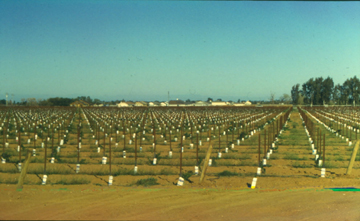 Editor’s
note: For this year’s Soil Science Highlights, Staff Writer Naomi Lubick
takes a look at a recent report on endangered soils.
Editor’s
note: For this year’s Soil Science Highlights, Staff Writer Naomi Lubick
takes a look at a recent report on endangered soils.
 Editor’s
note: For this year’s Soil Science Highlights, Staff Writer Naomi Lubick
takes a look at a recent report on endangered soils.
Editor’s
note: For this year’s Soil Science Highlights, Staff Writer Naomi Lubick
takes a look at a recent report on endangered soils.
Just as a house without a foundation will fall, an ecosystem built on a specific
soil type may die once the soil is destroyed. New analyses of the distribution
of soils across the United States show a significant loss of certain soil types,
and that slightly less than 5 percent of the rarest soils in the country are
facing possible extinction.
Agriculture and urban land use, seen together in this vineyard in central California,
not only change the landscape, but also change the soil. Courtesy of Ronald
Amundson.
The report, published last October in Ecosystems, finds that agriculture
and urban development have disrupted soil profiles across the nation. Regions
in the Midwest and California in particular have lost more than half their original
soils, and in some places, up to 80 percent of the rare soils have been disturbed.
Using GIS, the researchers mapped the distribution of soil series at the state
and local scale, using the U.S. Department of Agriculture (USDA) soil taxonomy
system. Soil series are comparable to biological species, representing the most
specific level of identification according to soil characteristics.
Randall Schaetzl, a soil geographer at Michigan State University in East Lansing
who was not involved in the study, calls the cataloging innovative and exciting.
“No one’s ever thought of it before,” he says. Because the work
is based on the USDA’s most broad-brush datasets, Schaetzl says that the
current study “actually forewarns us that with a better [smaller scale]
database that will soon be available from the USDA, we will find even more such
endangered soils.” The added value of the report, Schaetzl says, is the
connection the researchers make between soil and ecosystems biodiversity.
“The soil and geology provide the real underpinnings to the landscape,”
says Ronald Amundson of the University of California at Berkeley, lead author
of the report. In the Midwest, Amundson and his co-workers have found endangered
soils preserved only in pioneer cemetery plots, with tiny slices of prairie
grasses that have all but disappeared. In the San Joaquin Valley in California,
the state’s major agricultural center, the vernal pools — ephemeral
ponds fed by spring rain — are disappearing because of agriculture and
urbanization. These land uses destroy the soil type, known as the San Joaquin
series, that supports the ponds.
That series, which is California’s state soil, contains a layer of cemented
silica that serves as a barrier to water percolating down from the surface.
“Farmers destroy that hardpan in order to use that soil,” says Michael
Singer, a soil scientist at the University of California at Davis, who sometimes
teaches with Amundson in the field. The presence of such a water barrier creates
vernal ponds, which support a variety of plants and animals, from the endangered
alkali milkvetch to the California tiger salamander.
Though most people would not rank soils with redwood trees or endangered animal
species, soil is as necessary to preserve as any of those things, Singer says.
“In these soil ecosystems, there may be the same kind of great potential
for discovery that people claim for the rainforests.”
Naomi Lubick
 |
Geotimes Home | AGI Home | Information Services | Geoscience Education | Public Policy | Programs | Publications | Careers |